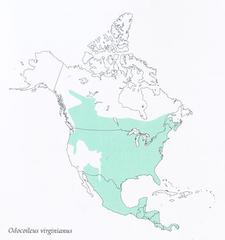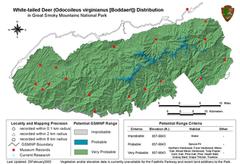|
|
Overview |
White-tailed deer prefer areas where dense woods and thickets alternate with open
meadows and forest glades. Forest margins, orchards, and farmland generally
provide excellent habitat.
- Special Protection Status
- Rangewide:
The white-tailed deer are classified as a game species in most states
and are protected by state game laws.
- In Park:
All plants and animals are protected within Great
Smoky Mountains National Park.
Collection requires a permit which is usually granted only for
research or educational purposes.
|
|
|
Identification |
- Adult total length:
4 1/2 - 6 3/4 ft. (134 - 206 cm)
- Tail:
6 - 13 in. (15 - 33 cm)
- Height at shoulder:
3 - 3 1/2 ft. (90 - 105 cm)
- Weight:
150 - 300 lbs. (67.5 - 135 kg)
-
Physical Characteristics:
During the summer, the back, sides, and limbs are usually reddish-brown;
the heavier winter coat is grayish. The throat and underparts are white
during all seasons. One of the most familiar characteristics of the
white-tailed deer is the white fur on the undersurface and edges of the
tail that is highly visible on the elevated tail of a startled or
frightened deer.
Deer have a number of prominent glands that secrete substances (pheromones)
that may be used to attract other members of their species and in
marking trails and territories.
Male white-tailed deer possess antlers. Antlers are branched structures
consisting of bone that are shed annually and are regrown each year.
Bucks usually shed their antlers during late December, January, and
February. New antlers appear several weeks after shedding and grow rapidly
as the spring forage improves. Until they reach their full growth, antlers
are covered by a thin layer of finely haired skin known as the "velvet." The
velvet gradually loosens and is shed in pieces.
|
|
|
Names | |
|
|
|
Phylogeny |
| Taxonomic Category |
Scientific Name |
Common Name |
| Phylum |
Chordata |
Chordates |
| Class |
Mammalia |
Mammals |
| Order |
Artiodactyla
|
Even-toed Ungulates |
| Family |
Cervidae |
Deer |
| Subfamily |
Talpinae |
Moles |
|
|
|
Geographic distribution |
White-tailed deer are found from northern South America north through Mexico
and the United States to southern Canada (Smith, 1991).
They occur throughout the United States except in the arid portions of the
West and Southwest.
-
Range Maps
| North America |
Great Smokies |

|

|
-
Great Smoky Mountains National Park:
White-tailed deer were once common in some sections of the area
now included in the park. However, due to a combination of factors -
persistent hunting, running by dogs, disease, and predators - they
decreased in numbers. Almost disappearing from the park by about 1930.
The formation of the park at that period provided a refuge for these
animals, and they have been increasing ever since. They remained scarce
until the late 1940s, when small herds of seven or eight animals were
reported in Cades Cove. By the middle 1950s, the herd in Cades Cove had
built up considerably and, since that time, they are commonly observed
there. By the early 1960s, white-tailed deer were being reported from
many places in the park. By 1993, deer existed in low densities throughout
much of the park. They continue to be most common in the western third
of the park and are uncommon in the spruce-fir region
(Linzey, 1995b).
- Blount Co.:
Abrams Creek; Cades Cove; Parsons Branch; Gregory Ridge Trail; Gregory Bald.
- Cocke Co.:
Cosby; Ground Hog Creek.
- Sevier Co.:
Greenbrier; near Fighting Creek.
- Haywood Co.:
Big Creek; Cataloochee.
- Swain Co.:
Deep Creek; Collins Creek; Fontana Lake; Hazel Creek;
Noland Creek; Russell Field; Heintooga.
|
|
|
Natural history |
- Reproduction
Female deer produce a single annual litter. A female's first litter
usually consists of one fawn; two are most common thereafter. In the
park, breeding usually occurs from November to mid-December. Following
a gestation of 197 to 222 days, fawns are usually born from late May
through early July (Linzey, 1995a). Mating deer were
observed in Cades Cove on November 1 (Stupka, 1956).
A doe and a newborn fawn were observed on June 20
(Stupka, 1956). The tracks of an adult and a fawn
were seen along the Gregory Ridge Trail (4,200 feet) on June 17
(Stupka, 1939), while several does with fawns were
noted near Hazel Creek in August, 1963. Wathen and New (1989)
reported fawn-at-heel counts (fawns: does) ranging from 18:100 in 1984 to 20:100
in 1985 for the Cades Cove deer herd, suggesting a low rate of productivity.
- Longevity
Few white-tailed deer live beyond four or five years in the wild, although
they may live up to 20 years in captivity (Whitaker and Hamilton, 1998).
- Terrestrial Ecology
Deer are primarily active in early morning and early evening throughout the year.
They generally spend the daylight hours in concealing cover and bed down in a
different site each day. They have no permanent shelter or den.
Deer live in family groups composed of an adult doe, her young of the year, and
her previous year's yearling does. Bucks are solitary in the fall, but congregate
in groups in spring and summer. Deer are shy, secretive, and alert. They possess
a good sense of sight and especially keen senses of hearing and smell.
During the period 1983-85, spotlight counts in Cades Cove yielded an estimate of
0.38 deer per hectare (2.63 hectares per deer), while monthly mark-recapture
estimates averaged 0.23 deer per hectare (4.4 hectares per deer)
(Wathen and New, 1989). The average annual home range was
147 hectares.
White-tailed deer are selective vegetarians choosing the most nutritious forage
that is seasonally available. During the spring and summer, leaves, twigs, mushrooms,
fruits, grasses, honeysuckle, and tree seedlings may be consumed. In the
fall, acorns and other mast usually form a major portion of the diet.
- Predators and Defense
Wathen and New (1989) reported female fawn mortality
rates of approximately 25 percent. Predation was one of the major causes
of death (27%), with dogs or coyotes suspected as being the major predators.
Black bears are known to kill some park deer. Males appear to be more
susceptible to mortality factors than females.
- Parasites
Seventy-nine of 127 deer (62%) from Cades Cove were infested with lice.
Tricholipeurus parallelus was found on 51 deer (40%) and
Tricholipeurus lipeuroides was found on 36 deer (28%)
(Hribar et. al., 1986). One doe also harbored
Solenopotes ferrisi. Blood samples were collected from 518
deer in Cades Cove between 1980 and 1985 (Wathen and New, 1989).
Antibodies were recorded for hemorrhagic disease viruses,
leptospirosis, bovine virus diarrhea (BVD), infectious bovine
rhinotracheitis (IBR), and anaplasmosis. No antibodies were recorded
for brucellosis.
|
|
|
Links to other sites | |
|
|
|
References |
-
Linzey, D. W. 1995a.
Mammals of Great Smoky Mountains National Park.
Blacksburg, Virginia: The McDonald & Woodward Publishing Company, Inc.
-
Linzey, D. W. 1995b.
Mammals of Great Smoky Mountains National Park-1995 Update.
Journal of the Elisha Mitchell Scientific Society 111(1):1-81.
-
Hesselton, W. T. and R. M. Hesselton. 1982.
White-tailed Deer. Pages 878-901. In: J. A. Chapman and G. A. Feldhamer (editors).
Wild Mammals of North America. Baltimore: The Johns Hopkins
University Press.
-
Hribar, L. J., G. B. Wilson, and R. R. Gerhardt. 1986.
Infestations of lice on white-tailed deer, Odocoileus virginianus,
in the Great Smoky Mountains National Park, Tennessee, USA. Journal of
Wildlife Diseases 22 (2): 272.
-
Smith, W. P. 1991.
Odocoileus virginianus. Mammalian Species No. 388: 1-13.
American Society of Mammalogists.
-
Stupka, A. 1935-63.
Nature Journal, Great Smoky Mountains National Park. 28 vols.
(years) each with index. (Typewritten copy in files of
Great Smoky Mountains National Park.)
-
Wathen, W. G. and J. C. New, Jr. 1989.
The white-tailed deer of Cades Cove: population status, movements and
survey of infectious diseases. National Park Service Research/Resource Management Report SER-89/01.
-
Whitaker, J. O., Jr. and W. J. Hamilton, Jr. 1998.
Mammals of the Eastern United States. Ithaca, New York: Comstock Publishing Associates.
|
|
|
Acknowledgements |
- Text
- Photographs
- Map development
- Web page design & coding
- Denise Lim, University of Georgia, Athens
- John Pickering, University of Georgia, Athens
|
|
| Supported by | |
|
Following modified from North American Mammals, Smithsonian Institution
|
Top | See original
| &pull 20q v5.145 20180528: Error 301 Moved Permanently http://www.mnh.si.edu/mna/image_info.cfm?species_id=231 |
|
Following modified from University of Georgia Museum of Natural History
|
Top | See original
| &pull 20q v5.145 20180528: Error 301 Moved Permanently http://naturalhistory.uga.edu/~GMNH/gawildlife/index.php?page=speciespages/species_page&key=ovirginianus |
Updated: 2024-04-25 19:26:28 gmt
|